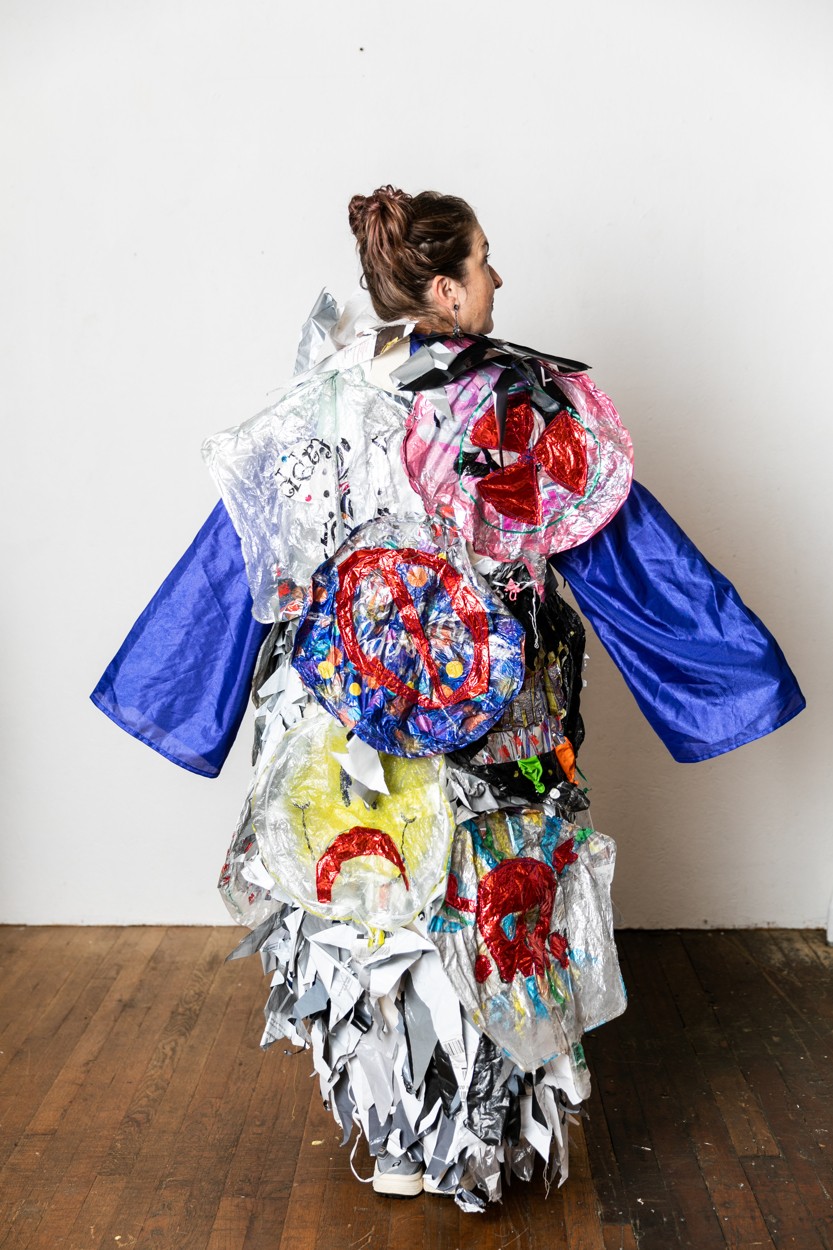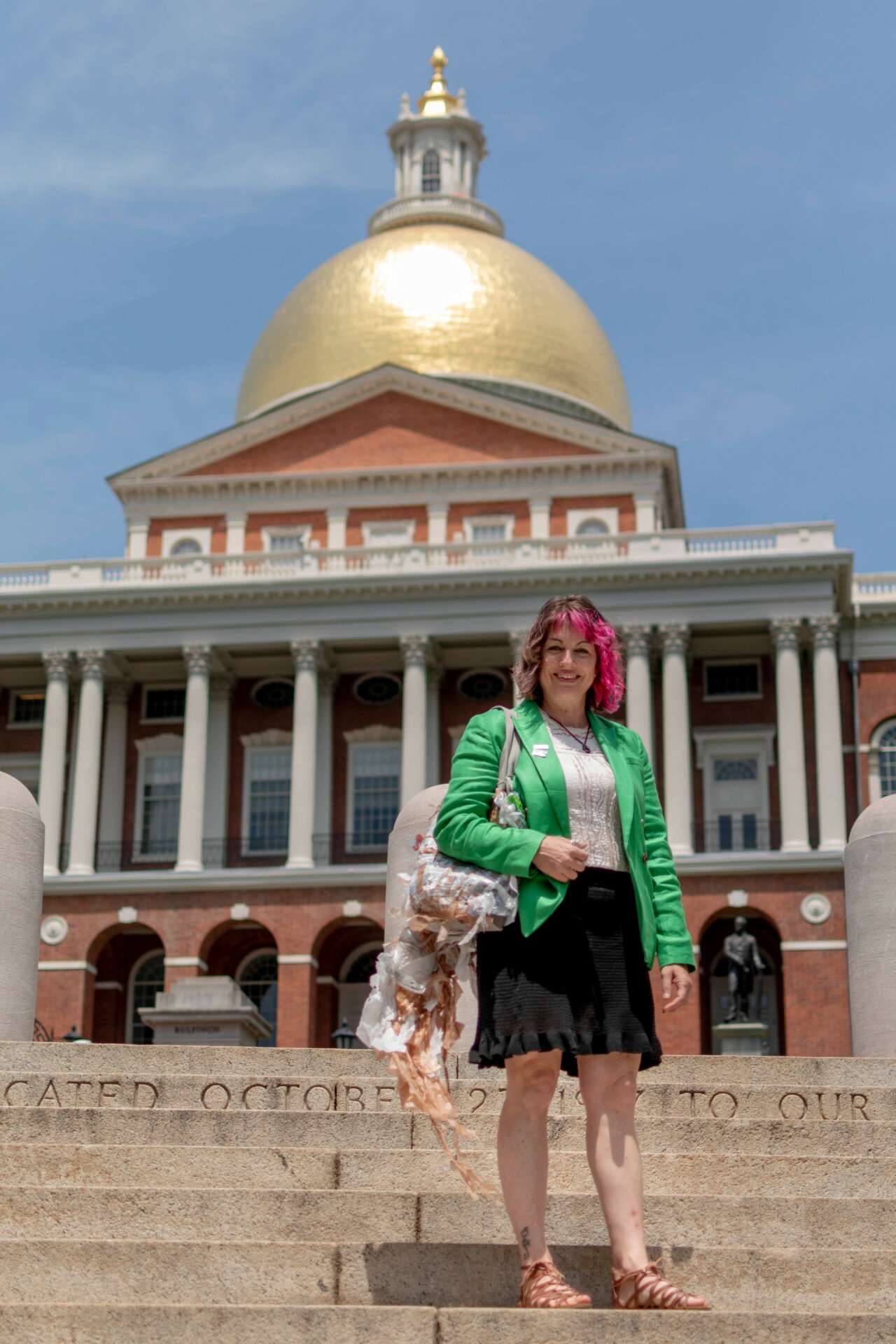Alright – so today we’ve got the honor of introducing you to Rebecca McGee Tuck. We think you’ll enjoy our conversation, we’ve shared it below.
Hi Rebecca McGee, thanks for joining us today. Can you talk to us about a project that’s meant a lot to you?
The materials that I use in my artwork are almost entirely discarded materials that I collect, clean and transform. For the last few years I have created sculpture using almost entirely beach debris that washes ashore. I call this series of work “Along the Wrack-line”. If you do not know what the wrack-line is– its the line of debris that washes up on the beach and is left behind as the high tide recedes. This sculpture series began because I was walking the same two mile stretch of beach on the South Shore of Massachusetts almost daily. As I walked I was picking up the trash and debris that I was encountering on the beach. I came to realize that I really loved the textures and colors of marine rope and line that I was picking up. On my walks I would collect between 5- 50 lbs of detritus– some of which I would properly dispose of, some that I could recycle and some that I would collect and clean to use in my sculpture. It so surprised me that I could return to the beach every day and continue to find 5- 50 lbs of trash and debris. The materials inspired me to create artworks that could be colorful and beautiful, but also informative. I wanted others to know what I was finding along our beaches. The artwork could draw people in and the content and context of where I collected my materials would help to spread the word about the hazards of excess plastic pollution and other debris that were poisoning our ocean. Through this series of ocean debris work, I was inspired to seek out organizations such as Surfrider Foundation and Be the Solution for Pollution. I joined these groups to help connect the art with the activism and connect with others who were also interested in preserving marine ecosystems and safeguarding the delicate balance of coastal habitats. Now activism has also led me to travel to Washington DC and the Massachusetts State House to advocate for bills that reduce fossil fuel use and help to ban single use plastic pollution.


As always, we appreciate you sharing your insights and we’ve got a few more questions for you, but before we get to all of that can you take a minute to introduce yourself and give our readers some of your back background and context?
I began my journey as an artist when I went to Massachusetts College of Art and Design in the early 90’s. I was not able to finish at that time in my life. 25 years later after my children were older, I went back to MassArt in my 40’s to finish what I had started. I ended up graduating with my BFA in Sculpture in 2019 and walking in graduation with my much younger colleagues. I was so very excited and inspired by my classes and professors at MassArt that I hit the ground running after I graduated– applying to every opportunity, creating a studio practice and a sustainable creative practice. What I became the most proud of was when I finally had beaten my fear of public speaking that had been difficult. This is especially a problem because artists are continually being asked to speak about process and artwork. Because I had said yes to everything such as library shows, middle school classroom visits, art association talks etc, I was getting more confident each time I spoke in front of a crowd. At this point I do not feel unreasonable fear of talking in front of an art loving audience who generously show up to hear me speak. I look forward to sharing my process, my passion for reuse of materials and of the health of our climate.



Is there a particular goal or mission driving your creative journey?
My primary mission for me as an artist is for my work to raise awareness about the interconnectedness of nature and of the importance of environmental stewardship that we must all join in on. I continue to walk the wrack line as the primary source of my art making materials but now I have begun to partner with other eco artists and organizations in order to create a greater awareness about how better to preserve our vulnerable ecosystems for future generations. I really believe that art has the unique ability to communicate difficult issues in a visually compelling way by making a platform to bring up abstract concepts in order to make them more tangible and easier to begin a conversation about.



What’s the most rewarding aspect of being a creative in your experience?
At this point the most rewarding aspect of being an artist is the connections that I have made. Not just other artists but with the groups of like minded eco activists who are doing the work to make change. Through my work I have done things that I never thought that I could do. I overcame my fear of public speaking and this year I was able to speak testimony about the trash that pollutes our ocean in front of Congressman and Lawmakers at state and federal levels. Also many students have reached out to interview me for their college thesis projects that speak about fossil fuels and beach debris. And finally I have been working with UMASS Dartmouth sculpture and sustainability students on an enormous public art piece that we planned together and will create together for presentation on Earth Day here in the South Coast of Massachusetts. Art, community and environmental activism has really made my life feel fulfilled!
Contact Info:
- Website: https://www.rebeccamcgeetuck.com/
- Instagram: @rebeccabombshellart
- Facebook: https://www.facebook.com/rebeccamcgeetuckart/
- Linkedin: https://www.linkedin.com/in/rebecca-mcgee-tuck-96b211176/
- Other: Threads: @Rebeccabombshellart
Image Credits
Carla McElroy Photography all except Alex Vai ( the 2 photos that I am wearing a green jacket)


